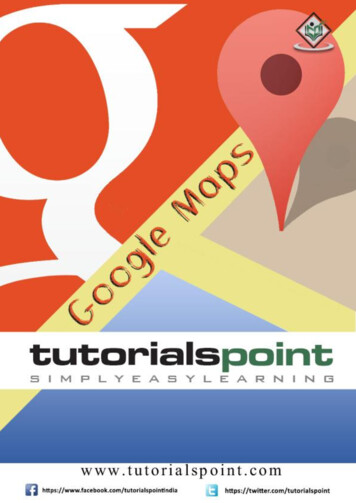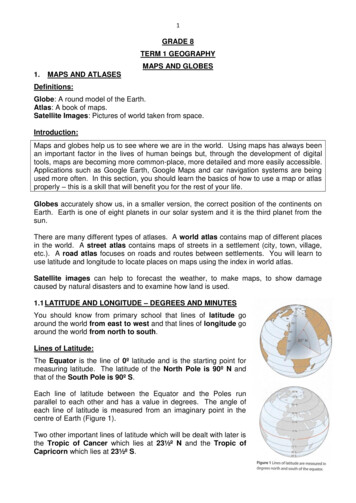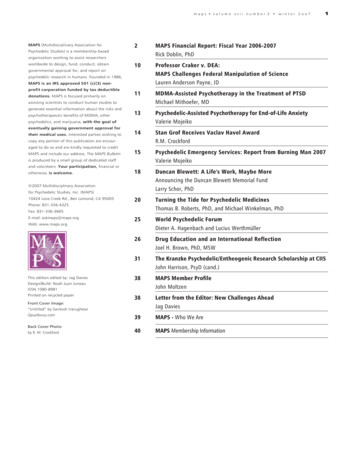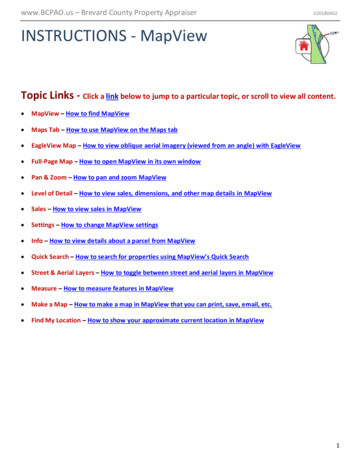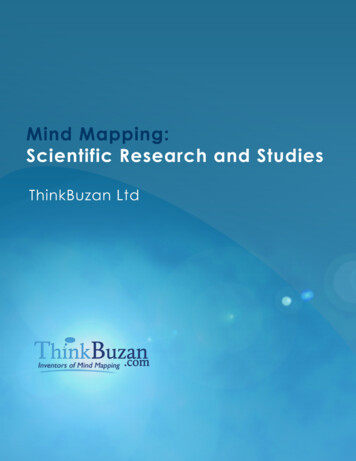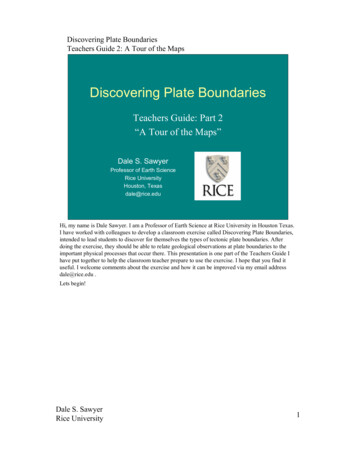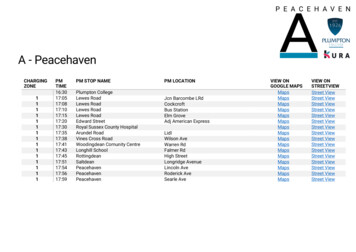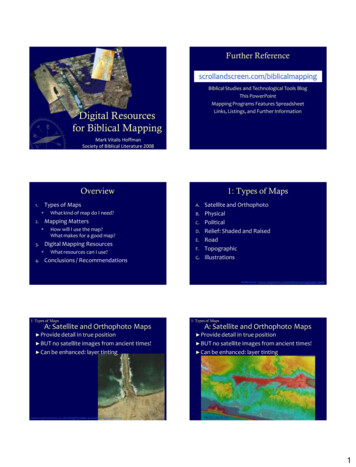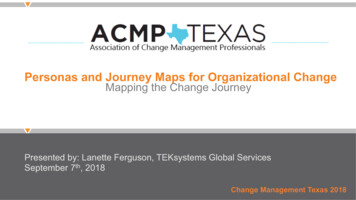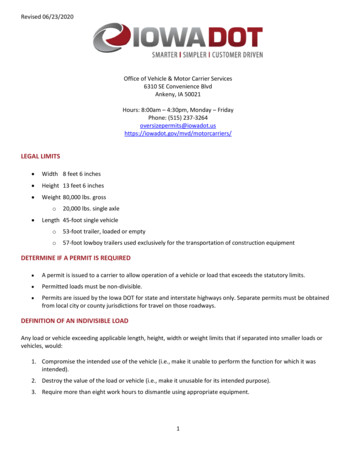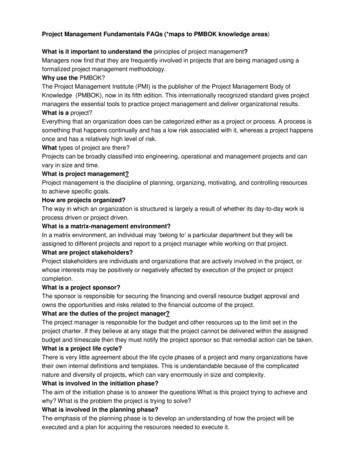
Transcription
Project Management Fundamentals FAQs (*maps to PMBOK knowledge areas)What is it important to understand the principles of project management?Managers now find that they are frequently involved in projects that are being managed using aformalized project management methodology.Why use the PMBOK?The Project Management Institute (PMI) is the publisher of the Project Management Body ofKnowledge (PMBOK), now in its fifth edition. This internationally recognized standard gives projectmanagers the essential tools to practice project management and deliver organizational results.What is a project?Everything that an organization does can be categorized either as a project or process. A process issomething that happens continually and has a low risk associated with it, whereas a project happensonce and has a relatively high level of risk.What types of project are there?Projects can be broadly classified into engineering, operational and management projects and canvary in size and time.What is project management?Project management is the discipline of planning, organizing, motivating, and controlling resourcesto achieve specific goals.How are projects organized?The way in which an organization is structured is largely a result of whether its day-to-day work isprocess driven or project driven.What is a matrix-management environment?In a matrix environment, an individual may ‘belong to’ a particular department but they will beassigned to different projects and report to a project manager while working on that project.What are project stakeholders?Project stakeholders are individuals and organizations that are actively involved in the project, orwhose interests may be positively or negatively affected by execution of the project or projectcompletion.What is a project sponsor?The sponsor is responsible for securing the financing and overall resource budget approval andowns the opportunities and risks related to the financial outcome of the project.What are the duties of the project manager?The project manager is responsible for the budget and other resources up to the limit set in theproject charter. If they believe at any stage that the project cannot be delivered within the assignedbudget and timescale then they must notify the project sponsor so that remedial action can be taken.What is a project life cycle?There is very little agreement about the life cycle phases of a project and many organizations havetheir own internal definitions and templates. This is understandable because of the complicatednature and diversity of projects, which can vary enormously in size and complexity.What is involved in the initiation phase?The aim of the initiation phase is to answer the questions What is this project trying to achieve andwhy? What is the problem the project is trying to solve?What is involved in the planning phase?The emphasis of the planning phase is to develop an understanding of how the project will beexecuted and a plan for acquiring the resources needed to execute it.
What is involved in the execution phase?Executing consists of the processes used to complete the work defined in the project plan toaccomplish the project's requirements.What is involved in the closure phase?This phase represents the formal completion of the project deliverables and their transfer to the finalbeneficiaries – usually internal or external customers.What are the PMBOK Process Groups?The PMBOK Guide divides the project life cycle into five process groups: initiating, planning,executing, controlling and monitoring, and closing. The five process groups have cleardependencies, are typically performed in the same sequence on each project, are independent ofapplication areas or industry focus, and are often iterated prior to completing the project.What are the PMBOK Knowledge Areas?The PMBOK Guide recognizes 47 processes arranged into ten supporting knowledge areas.These are numbered 4 to 13 according to their chapters in the PMBOK Guide. These areas aredefined by the specific knowledge requirements the project manager should be familiar with in orderto do a professional job.What are the project management processes?The 47 project management processes described in the PMBOK Guide can be organized in twodifferent ways: by Process Group and by Knowledge Area. Process groups are not meant to beprescriptive activities that are executed one after the other. The process groups are guides that aredesigned to help you to focus on what needs to be done at particular points in a project, phase, subphase, or work package.What is the origin of the PMBOK process groups?The PMBOK Guide process groups are derived from a business process model developed byWalter A. Shewhart and popularized by W. Edward Deming. This iterative four-step managementmethod is used for the control and continuous improvement of processes and products.What is the initiating process group?The initiating process group consists of processes necessary to define a new project or a new phaseof an existing project. It involves obtaining authorization for the project or project phase and definesobjectives, outcomes, and success criteria.What is the project charter?This formally authorizes a project or a phase and documents initial requirements that satisfy thestakeholder’s needs and expectations. It is normally written by the project sponsor or whoeverinitiated the project.Who are the stakeholders?Project stakeholders are individuals and organizations that are actively involved in the project, orwhose interests may be affected as a result of project execution or project completion.What is the planning process group?The planning process group provides guidelines for bringing together all of the different types ofplanning needed to run the project. Planning processes are found in every one of the ten knowledgeareas defined by the PMBOK .What is the project management plan?The project management plan is the major output from the planning process. Developing it is theprocess of documenting the actions necessary to define, prepare, integrate, and coordinate allsubsidiary plans.
What is the executing process group?The overall goal of the Executing Process Group is to set the teams in place to get the work doneefficiently and effectively so that the project stays on target with regard to scope and previouslyagreed goals.What is the monitoring and controlling process group?This process group involves every knowledge area except for human resources and is where theperformance of the project is measured and action is taken based on an analysis of this data.What is change control?Change control is a formal process used to ensure that changes to a product or system areintroduced in a controlled and coordinated manner. It reduces the possibility that unplanned changeswill be introduced.What is the closing process group?A carefully structured project closure phase should ensure that the project is brought to a controlledend.What are the process groups?Where a project is split into stages, the processes of these groups repeat in every stage of theproject. This means that each stage must be initiated, planned, executed, and closed, as well asmonitoring and controlling being present throughout each stage.What is Project Integration Management?The knowledge area of Integration Management coordinates and integrates the processes from theother knowledge areas. It is concerned with managing the dependencies between the variousPMBOK knowledge areas.What does *4.1 Develop Project Charter involve?This process involves developing a document that formally authorizes the existence of a project andprovides the project manager with the authority to apply organizational resources to project activities.What does *4.2 Develop Project Management Plan involve?This process involves defining, preparing, and coordinating all subsidiary plans and integrating theminto a comprehensive project management plan. The project’s integrated baselines and subsidiaryplans may be included within the project management plan.What does *4.3 Direct and Manage Project Work involve?This process involves leading and performing the work defined in the project management plan andimplementing approved changes to achieve the project’s objectives. The main inputs to this processare the Project Management Plan (described in detail in the previous section) and Approved ChangeRequests.What does *4.4 Monitor and Control Project Work involve?In the Planning Process (4.2), we plan the work; in the Executing Process (4.3), we work the plan;and in this Monitoring and Controlling Process (4.4), we check the work to make sure that it isactually going to plan. If it is not going to plan then changes need to be made in either the work ORthe plan, those requests for changes get fed into the following process, 4.5 Perform IntegratedChange Control.What does *4.5 Perform Integrated Change Control involve?This process involves reviewing all change requests; approving changes and managing changes todeliverables, organizational process assets, project documents, and the project management plan;and communicating their disposition.
What does *4.6 Close Project or Phase involve?This process involves finalizing all activities across all of the Project Management Process Groups toformally complete the phase or project.What is project scope management?The knowledge area of Scope Management includes the processes required to ensure that theproject includes all the work, and only the work required to complete the project successfully.What is scope creep?As well as defining the scope of the project in the planning stage it is also necessary to activelymanage it. This is because there are two groups of stakeholders that will almost invariably applypressure to change the scope of the project throughout its life cycle.What is the scope management process?At the point where the project scope statement is authorized, the scope of the project is frozen.Anything that implies that the actual project and what is defined in the scope management statementwill be materially different should trigger the scope management process.What does *5.1 Plan Scope Management involve?This process involves creating a Scope Management Plan that describes how the scope of theproject will be defined, validated and controlled so that it can be managed throughout the life of theproject.What does *5.2 Collect Requirements involve?This process is concerned with assessing, documenting, and managing stakeholder needs to meetproject objectives. All requirements should be gathered at the start because it is costly to makechanges as the project progresses.What does *5.3 Define Scope involve?This process involves creating a detailed description of the project and it's deliverables using theScope Management Plan, Project Charter and the Requirements Documentation.What does *5.4 Create Work Breakdown Structure involve?The creation of the WBS should be one of the first steps in the planning process, once therequirements specification for the project has been written. It should reflect the way the work will beperformed and the way in which project costs and data will be summarized and reported.What does *5.5 Validate Scope involve?This process involves taking the deliverables which have been internally checked in process 8.3Control Quality to see whether they meet the customer’s requirements, and then actually presentthem to the customer for formal acceptance.What does *5.6 Control Scope involve?This is the process of managing the changes to the scope baseline. There will inevitably be changesto this but it is important to ensure that these changes do not build upon each other incrementally.This is something referred to as scope creep and always produces unacceptable risks because thecombined effects of these incremental changes are seldom considered in total.What is scope management?Project Scope Management includes the processes required to ensure that the project includes allthe work required, and only the work required, to complete the project successfully. Managing theproject scope is primarily concerned with defining and controlling what is and is not included in theproject.What is project time management?Project Time Management includes processes required to manage the timely completion of the
project. It involves determining the delivery dates and milestones whilst taking all of the knownconstraints into account.What does *6.1 Plan Schedule Management involve?The process of establishing the policies, procedures, and documentation for planning, developing,managing, executing, and controlling the project schedule.What does *6.2 Define Activities involve?The high-level requirements are broken down into high-level tasks or deliverables. These are thanbroken down into activities and presented in the form of WBS (Work Breakdown Structure).What does *6.3 Sequence Activities involve?The activities identified in the previous step should be sequenced based on the order in which theyneed to be done depending on their interdependencies.What does *6.4 Estimate Activity Resources involve?The estimation of the amount and the types of resources required for activities is done in this step.What does*6.5 Estimate Activity Durations involve?This is a key step in the project planning process and there are a number of tools that can also beutilized to help you to estimate the required activity resources.What does *6.6 Develop Schedule involve?In order to create an accurate schedule, several parameters from the previous steps are requiredincluding: the activity sequence, duration of each activity, and the resource requirements.What does *6.7 Control Schedule involve?This process is part of monitoring and controlling and is sometimes referred to as ‘working the plan’in contrast with the first five processes which are all to do with ‘planning the work’.What is project cost management?This knowledge area includes the processes involved in planning, estimating, budgeting andcontrolling costs so that a project can be completed within the approved budget.What does *7.1 Plan Cost Management involve?This process establishes the policies, procedures, and documentation for planning, managing,expending, and controlling project costs. The key benefit of this process is that it provides guidanceand direction on how the project costs will be managed throughout the project.What does *7.2 Estimate Costs involve?This step involves estimating the costs of each activity in the project including both human resourceand physical resource costs. Because this step often occurs in the planning phase, it is important tounderstand that the estimated costs are your “best guesses” at the actual costs of each activity.What does *7.3 Determine Budget involve?Using your best-guess estimates, the next step is to create a realistic project budget. In this step,you will determine the cost baseline and the funding requirements for the project. A good projectbudget will help you make key decisions with respect to the project schedule and resource allocationconstraints.What does *7.4 Control Costs involve?Good project managers will carefully monitor the cost of their projects. This includes watching to seewhere actual cost has varied from estimated cost. Cost control also involves informing thestakeholders of cost discrepancies that vary too much from the budgeted cost.What is project cost management?Cost Management procedures are used to create a budget, and to monitor performance relative tothat budget. Effective monitoring requires a focus on the actual and forecast consumption ofelements such as people's time, materials, equipment, facilities, etc.
What is project quality management?Project Quality Management includes the processes and activities of the performing organizationthat determine quality policies, objectives, and responsibilities so that the project will satisfy theneeds for which it was undertaken.What does *8.1 Plan Quality Management involve?This process is about deciding what quality means for this particular project and its deliverables.What are the seven basic quality tools?Most of the tools and techniques described here are based on statistical analysis and are mostappropriate where the project deliverables are products that can be measured in some way.What does *8.2 Perform Quality Assurance involve?Quality assurance is part of the executing process and is concerned with making sure that thequality objectives are met. It is focused on process improvement.What does *8.3 Perform Quality Control involve?The PMBOK defines quality control as monitoring specific project results to determine whether theycomply with the relevant quality standards and identifying ways to eliminate the cause ofunsatisfactory results.What is ISO Quality Management involve?One of the changes to the 5th Edition PMBOK Guide is to make the quality management part ofproject management conform to the International Organization for Standardization quality standards.What is project human resources management?The purpose of Project Human Resource Management is to ensure that the project has sufficienthuman resources, with the correct skill sets and experience, for the project to be successfullycompleted.What does *9.1 Develop Human Resource Plan involve?The develop HR plan details the project roles, responsibilities, required skills and reportingrelationships required for project success.What does *9.2 Acquire Project Team involve?The process of acquiring a project team takes place within the executing process group and isconcerned with confirming human resource availability and obtaining the personnel needed tocomplete project assignments.What does *9.3 Develop Project Team involve?This is an executing process whose objective is to build a team that can work well together.What does *9.4 Manage Project Team involve?This process involves tracking team member performance, providing feedback, resolving issues, andmanaging changes to optimize project performance.What are the functions of human resource management?This knowledge area contains the tools and techniques needed to resolve HR conflicts as much aspossible.What is project communications management involve?Communications form an essential part of any project and unlike technical areas, for exampleestimating and risk assessment; communication is something that the project manager has to takedirect personal responsibility for.What does *10.1 Plan Communications Management involve?Identifying the information needs of the stakeholders and determining a suitable means of meetingthose needs are important factors for project success.
What does *10.2 Manage Communications involve?The purpose of this process is to keep the various stakeholders informed on the progress of theproject. This is done according to the communications management plan was created within the plancommunications process.What does *10.3 Control Communications involve?This is the process of monitoring and controlling communications throughout the entire project lifecycle to ensure the information needs of the project stakeholders are met.What is project risk management?A risk is a future event that may or may not happen, but if it does occur it will have an effect onproject scope, schedule, cost, or quality. It may have one or more causes and, if it occurs, it mayhave one or more impacts.What does *11.1 Plan Risk Management involve?This is the process of creating the risk management plan. This plan details how the projectmanagement team will perform risk management for this project.What does *11.2 Identify Risks involve?This is the process of determining risks that may affect the project and assessing the impact of therisk should it occur.What does *11.3 Perform Qualitative Risk Analysis involve?This process analyses each risk from the risk register in terms of its probability and impact on theproject if it were to occur.What does *11.4 Perform Quantitative Risk Analysis involve?This is the process of analyzing the effect of those risks identified in the previous process as havingthe potential to substantially impact the project.What does *11.5 Plan Risk Response involve?This is the process of developing options and actions to enhance opportunities and to reduce threatsto the project.What does *11.6 Control Risks involve?This is the process of implementing risk response plans, tracking identified risks, monitoring residualrisks, identifying new risks, and evaluating risk process effectiveness throughout the project.What is project risk management?Risk plays a significant part in the planning of any project that requires a commitment of time andresources. A project manager should have a clear understanding of the risk tolerance of the projectand organization from the outset.What is project procurement management?Almost all projects will require some external resources, services or products to be able to meet theirobjective. Those that cannot be provided internally will need to be purchased from an externalsource. The more complex a project is the more likelihood it will need outside specialists to meet itsobjective.What does *12.1 Plan Procurement Management involve?This process determines which products or services a project will need to procure from an externalsource. Once this has been decided the project manager will determine the appropriate types ofcontracts that will need to be used on the project.What does *12.2 Conduct Procurements involve?This is the process of obtaining seller responses, selecting a seller, and awarding a contract. It mayneed to occur multiple times if there are multiple contracts and for each instance it will includes
issuing the bid package to potential sellers, evaluating potential seller proposals and finally selectingthe winning seller proposal.What does *12.3 Control Procurement involve?This is the process of managing relationships with sellers, monitoring contract performance, takingcorrective actions if required, and controlling change.What does *12.4 Close Procurements involve?This is the process of completing individual project procurements and involves verification that allwork and deliverables were acceptable, as well as administrative activities such as finalizing openclaims, updating records to reflect final results and archiving this information for future use.What is project procurement management involve?The PMBOK framework described in this eBook gives you a proven standard to use for theprocurement aspects of your project. It also enables a seamless interface between you and anorganization’s procurement department.What are the different types of procurement contract?There are several different types of contract that can be used, although the most common is thefixed-price type, which involves setting a fixed total price for a precisely defined product or service tobe provided.What is project stakeholder management?Project Stakeholder Management includes the processes required to identify the people, groups, ororganizations that could impact or be impacted by the project.What does *13.1 Identify Stakeholders involve?This is the process that identifies people, groups, or organizations that could impact or be impactedby a decision, activity, or outcome of the project. It analyzes and documents their interests in andinfluence on the project.What does *13.2 Plan Stakeholder Management involve?This is the process that develops appropriate management strategies to effectively engagestakeholders throughout the project.What does *13.3 Manage Stakeholder Engagement involve?This is the process that communicates and works with stakeholders to meet their needs andexpectations, address issues as they occur, and support stakeholder engagement.What does *13.4 Control Stakeholder Engagement involve?This is the process that monitors overall project stakeholder relationships, adjusts strategies andplans for engaging stakeholders.
formalized project management methodology. Why use the PMBOK? The Project Management Institute (PMI) is the publisher of the Project Management Body of Knowledge (PMBOK), now in its fifth edition. This internationally recognized standard gives project managers the essential tools to practice project management and deliver organizational results.

